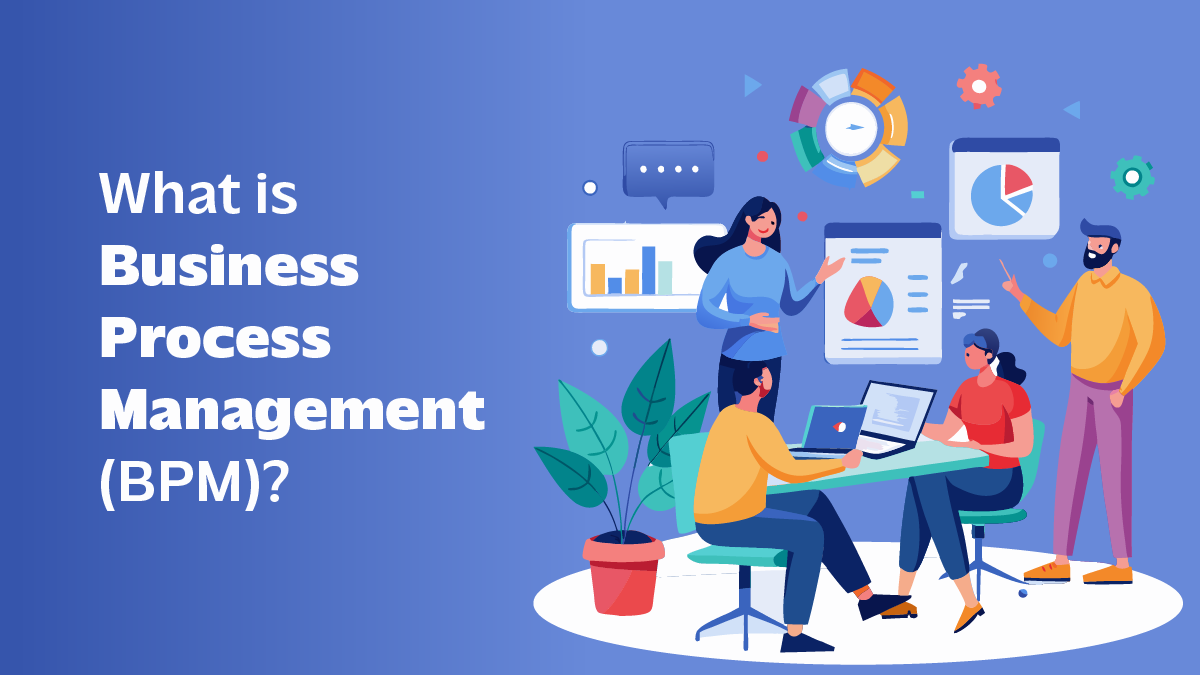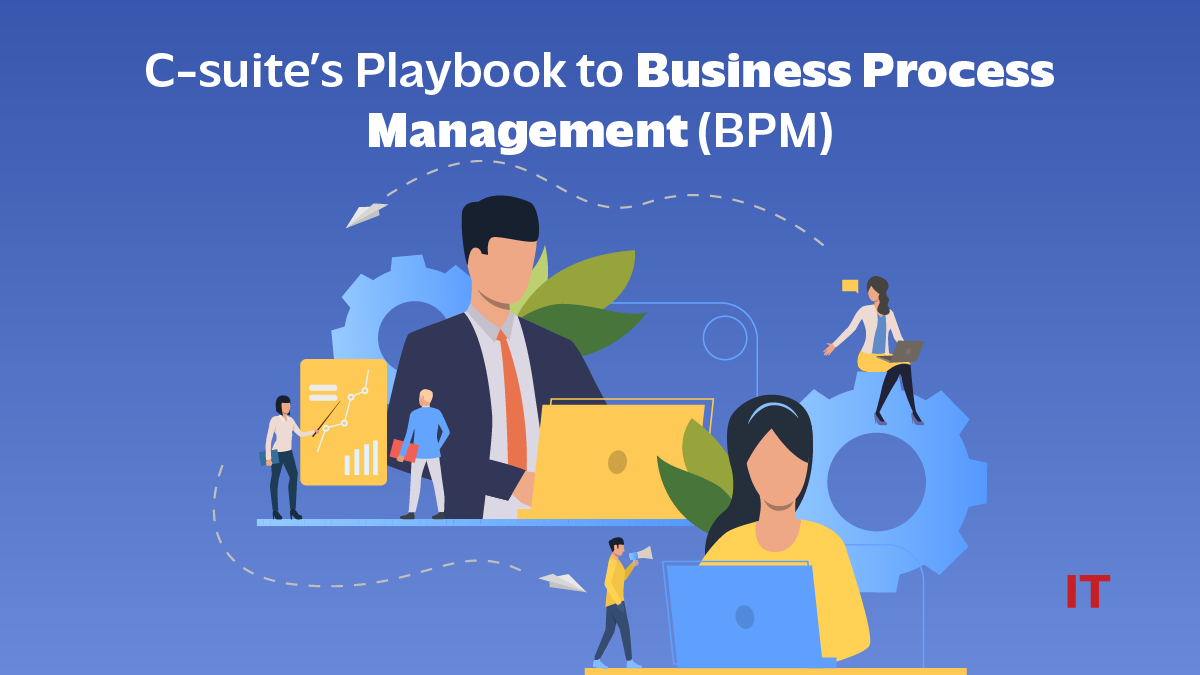According to Infosys, surveys highlight nearly 70% of business owners consider business process management (BPM) useful in managing and measuring processes. In this blog, let us have a look at the definition of BPM, its types, benefits, stages in the BPM lifecycle, and best practices.
What is Business Process Management(BPM)?
 Business process management is an approach that leverages multiple strategies to develop, strategize, execute, evaluate, and optimize business operations. BPM aligns the workforce, data, and technology to deliver results that are in alignment with the business objectives. Business processes could be repetitive and organized or unorganized and varying. Enterprises are seeking opportunities to integrate business process management tools in their enterprise tech stack to streamline their operations. Decision makers should consider investing in information technology (IT) systems and operational technology (OT) systems that align with business goals.
Business process management is an approach that leverages multiple strategies to develop, strategize, execute, evaluate, and optimize business operations. BPM aligns the workforce, data, and technology to deliver results that are in alignment with the business objectives. Business processes could be repetitive and organized or unorganized and varying. Enterprises are seeking opportunities to integrate business process management tools in their enterprise tech stack to streamline their operations. Decision makers should consider investing in information technology (IT) systems and operational technology (OT) systems that align with business goals.
What are the Types of BPM?
Business process management can be segmented into the following three categories:
● Integration-Driven BPM
Work processes that do not need human interaction are categorized as integration-centric BPM. These work operations rely on application programming interfaces (APIs) and strategies that collate data throughout all the systems, including customer relationship management (CRM) or human resource management system (HRMS)
● Human-Driven BPM
Workforce-centric BPM revolves around operations that require human interaction, particularly in tasks where approvals are needed. Interactive user interfaces of business process management tools have drag-and-drop functionalities that enable leaders to allocate tasks to various roles. This approach streamlines the work operations, as it holds the workforce accountable for the work.
● Document-Driven BPM
Document-centric BPM focuses on workflows that include documentation like a contract. If enterprises buy a product or service, they go through various stages and rounds of approval to design a service-level agreement between the customer and the service provider.
Also Read: 5 Types of Business Technology All Businesses Should Invest In
What are the Benefits of Business Process Management?
The organized approach of BPM to manage work processes enhances the quality of work and operational efficiency. There are the key factors that businesses need to consider when adopting a BPM.
A well-designed BPM strategy can assist organizations in reducing waste, minimizing mistakes, and lower operating costs. It would also have an impact on improving the compliance, agility, and efficiency of the business operations. A well-executed business process management approach assists in offering top-notch products and services to their clients.
Following are a few additional benefits of business process management:
- BPM prioritizes structuring workflows to minimize the risk of human mistakes.
- The best BPM tools have analytics integrated to offer leaders better visibility into the performance of work processes and assist them in determining the challenges.
- BPM tools with automation help enterprises optimize their efficiency and allow the workforce to focus on more important tasks that need human expertise.
- Above mentioned benefits of BPM allow the workforce more time to determine other process improvements and automations for constant optimization of business processes.
What are the Stages In a BPM Lifecycle?
 The following are the phases included in a complete BPM lifecycle:
The following are the phases included in a complete BPM lifecycle:
1.Develop
Most of the business processes will have a form that gathers information and a workflow to process the data. Decision makers should consider designing a form and determining who is accountable for executing every task in the operations. This stage of BPM is also widely known as business process mapping.
2. Strategize
At this phase of BPM, enterprises can showcase the processes in a visual layout. Decision makers can specify the details, such as deadlines and conditions, to offer a better understanding of the consequences of the events and data flow throughout the process.
3. Execute
During this phase, enterprises can deploy the processes by making them live for a few teams, and post the successful testing, they can be deployed throughout the organization. It is crucial to limit the access to sensitive information.
4. Evaluate
Business leaders need to track the process as it goes through. It is essential to set the right metrics to determine the progress, evaluate the effectiveness, and understand the challenges to ensure the process tracking is done efficiently.
5. Optimize
Post-evaluation of the business process management, it is important to understand the necessary modifications that need to be made in the operation to improve efficiency.
What are the Best Practices to Manage Business Processes?
Following are a few best practices that have evolved over the years to optimize BPM:
Determine the Business Objectives and Goals
It is crucial to determine the expected business outcomes of a business process and to ensure that the workflows are in alignment with the overall business objectives.
● Include the Stakeholders and The Workforce
It is essential to include the entire workforce and the key stakeholders in the development and management of business processes. This approach to BPM can ensure that the entire workforce and stakeholders are in alignment with the operational workflows and its outcomes.
● Documentation and Evaluation of Work Processes
In-depth documentation of business processes can assist enterprises in determining how they work, identifying areas for improvement, and monitoring the progress gradually.
● Utilize Process Modeling Strategies
Leveraging process modeling strategies such as flowcharts and business process model and notation (BPMN) can assist enterprises in visualizing and determining the processes and detecting potential challenges and inefficiencies.
● Regularly Track and Evaluate Process Performance
Enterprises need to monitor and analyze the performance of their business process management strategies at regular intervals. It is essential to leverage this data to detect and overcome any concerns in the process.
● Integrate the Best Business Process Management Tools in The Tech Stack
Integrating BPM tools with automation technologies will simplify and enhance business processes, which minimize the requirement for manual labor and enhance efficiency.
● Adopt a Culture of Constant BPM Enhancement
Business leaders need to adopt a culture of continuous improvement. It will help them to remain agile and adaptable to ensure the business process evolves to suffice the evolving needs.
Wrapping Up Business Process Management
Business process management is not a tool but is a practice of any organization. However, businesses are exploring opportunities to integrate automation into their BPM tools to identify process enhancements. Embracing automation in BPM helps make work operations more efficient to minimize costs, complexity, and mistakes.
































